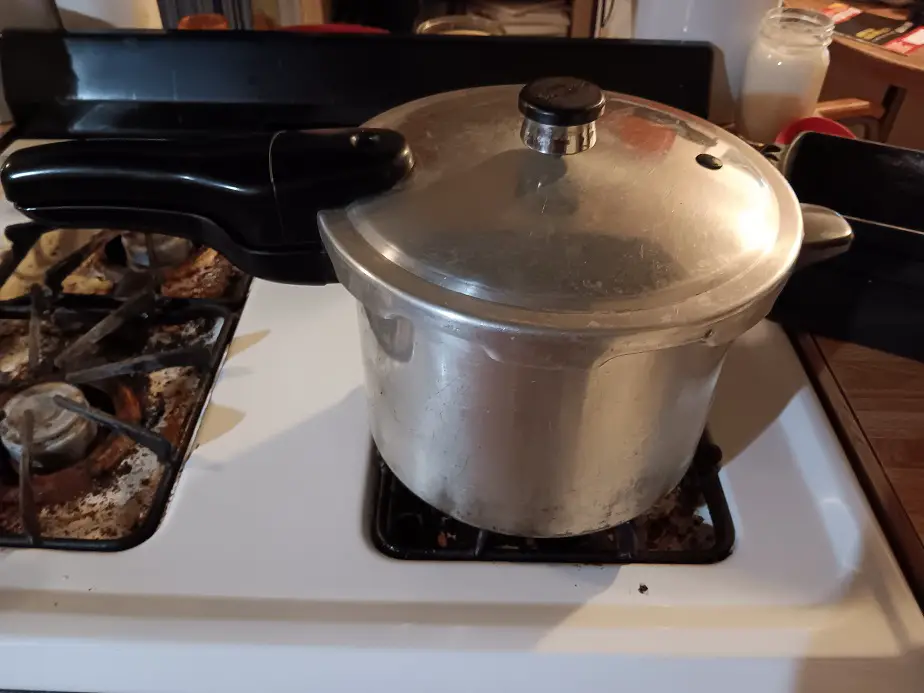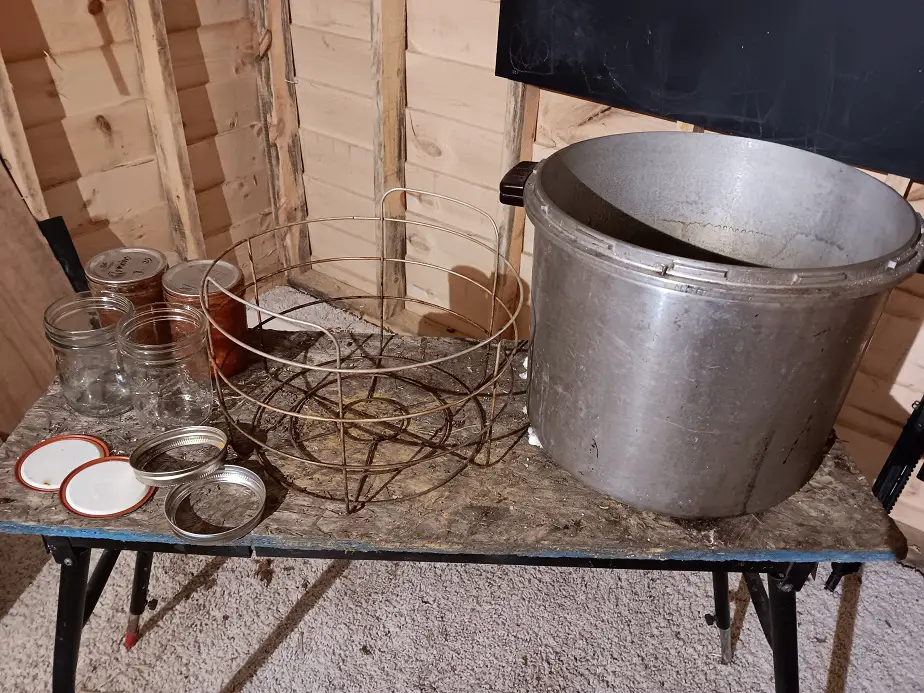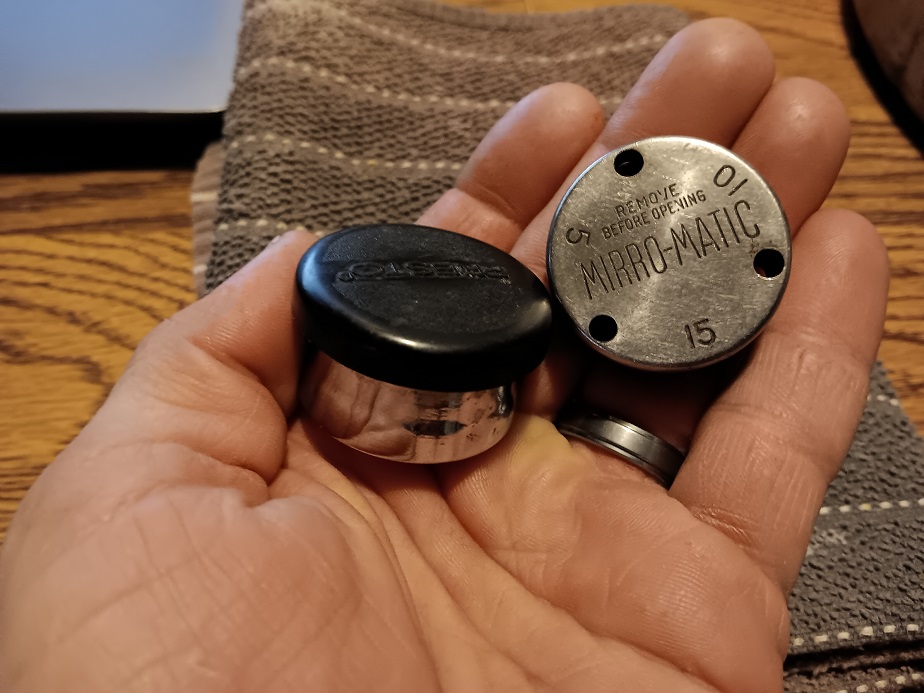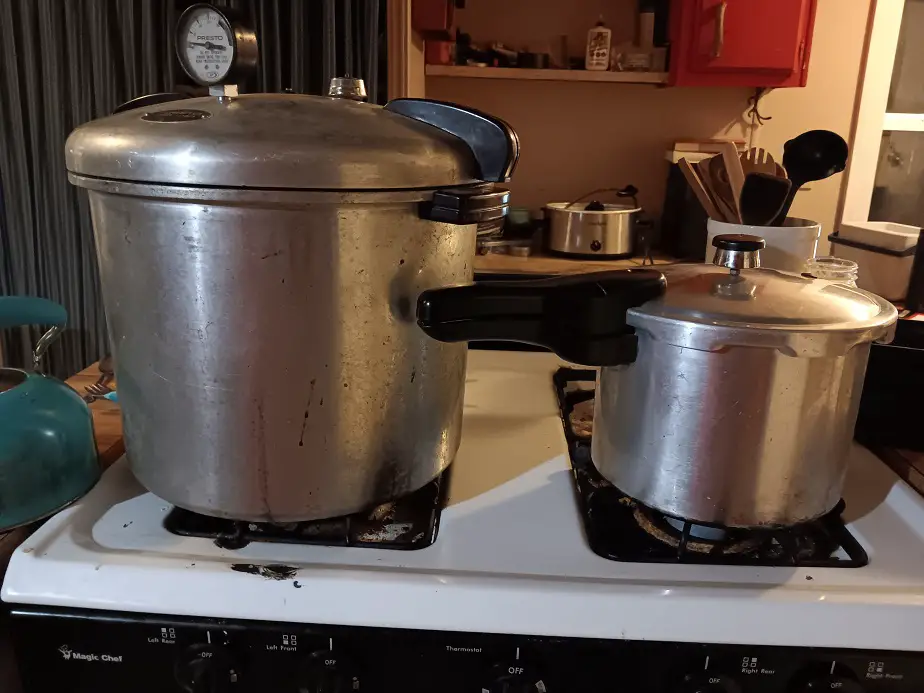Pressure canning has been a vast improvement in our food storage systems. I purchased four different pressure canners and have used others. Here’s what my wife and I have to say.
The best new pressure canners for beginners are the Presto 23-quart canner and the Presto 8-quart cooker/canner. The 23-quart canner is better for a family. The 8-quart is functional for one or two people but doesn’t fit many quart jars. The Mirro 22-quart pressure canner is also a good option.
The USDA National Center for Home Food Preservation requires two things of all pressure cookers.
- It must have a way to vent steam while heating up, prior to pressurizing.
- It must have a well-calibrated pressure control system
- They also recommend that the pot hold at least four quart jars in the upright position while on a rack of some sort to keep them off the bottom of the pot.
Let’s talk about the different models, their uses, and the value you actually get from them.

Presto 8-Quart Pressure Cooker/Canner
The 8-quart Presto is the best pressure canner for beginners. It’s marketed more as a pressure cooker due to its moderate size but it still falls under the USDA criteria for a pressure canner. It will fit 7-9 pint jars or 3-4 quart jars depending on the style and dimensions of the jars.
It’s a lightweight model that’s of a similar design to most all modern pressure canners. The wall thickness is the same as for the 23-quart Presto pressure canner. It also has the same pressure control system and jiggler weight as the larger model.
I actually started with the 6-quart model, but I don’t recommend that one as highly. It only fits about three pints or 1-2 quart jars, depending on how tall and wide the mouths are. It worked good enough for just my wife and I, but the 8-quart model is more conducive to actually putting up more food storage.

The 8-quart is about the same price and more functional, so I recommend it as a first choice. You can get it in stainless steel or aluminum. I went with aluminum because it was cheaper. It works just fine. Both come with a little disk-shaped rack to keep cans off the bottom.
Presto uses a non-rubber gasket that outperforms and outlasts all the other brands’ more traditional rubber gasket. Mine is almost 8 years old and still going great after being used 3-4 times a week.
There is a locking mechanism that prevents the lid from being loosened while it’s under pressure, and like all pressure cookers and canners, there’s a blow-out plug to prevent a dangerous pressure scenario.
If I remember correctly, the 6-quart model specifically is rated to withstand over 40 psi without catastrophic failure and the blow-out plug will pop out at 20-21 psi. The manufacturer told me it’s quite hard to get it to over 17 psi, and it rarely can go over 15.
The unit is designed to self-regulate at 15 psi, but it’s possible to overpressure it with a high-output outdoor propane burner or if the vent tube is plugged up before heating up the pot. So what I’m saying is, modern pressure canners are very safe and I’ve never heard of one of them having a mechanical failure.
Both sizes currently sell for around forty or fifty dollars for the aluminum option. Well worth it in my opinion. But, if you want to do larger batches for storing up more food in a short time, There’s some great options that’ll do you well.

Presto 23-Quart Pressure Canner
The Presto 23-quart pressure canner is a wonderful option for beginners. It’s cheap for its size, durable, and easy to do large batches in. It has twice the jar capacity of the 8-quart model, fitting about 7 quart jars or 20 pints. It sells for between $125 and $150, and has a dial gauge for precise management of pressure.
This unit is pretty awesome. It’s got a dial gauge and counterweight, and it takes a replaceable (long-lasting) rubber gasket that seats into a slot on edge of the lid. All my pressure canners use a rubber seal. The only one that doesn’t seal well is from 1968.
We were just given that canner and I still need to get a new seal. they usually last 5-10 years with heavy use, so it’s no drawback at all. Once in a while, I will clean the gasket a bit if it’s getting gummy or cruddy. I bought some seals last year. I think I paid $15 for a 2-pack. I can even find replacement seals for most of the antique models because they’re usually compatible with modern designs.
Mirro 22-Quart Pressure Canner
The Mirro 22-quart pressure canner is another great introductory option. It’s one of the cheaper ones, and it’s still ful-size. This is the one I see on store shelves more than any other. It’s of incredibly similar construction to the Presto and every bit as good. This canner will last you a lifetime with minimal care.
I don’t own the Mirro, but I’ve nothing against it. The first pressure cooker I ever bought was a Mirro from the 50s. I found it at GoodWill and all it needed was a gasket that I found on Amazon. I don’t have that pot anymore but I did save the jiggler weight because it fit a different pressure canner my wife had.
The All-American Pressure Canner
The All-American Pressure Canner is a top-of-the-line of pressure canner. It doesn’t take any gasket, has thicker walls than all other canners, and has the best warranty in the industry. It’s heavy, humungous, and quite expensive. While it’s nice, the price point is a deal breaker for a lot of people.
My father-in-law has one. So does my mom. They’re great canners and will outlast your lifetime, but expect to pay $500 or more for it, plus shipping. There is a lot of different sizes ranging from 15-quart to 45-quart. The more popular models seem to be the 30 and 45-quart.
The are very tall pots. The idea is that you can, with the right types of racks, stack layers of jars in the pot at the same time to process a huge amount in one go. The downsides to that it that it’s a ton of weight on a stovetop; many designs can’t handle it, and that it takes a very long time to heat up a full pot like that to pressure.
You can’t start your processing times until the pot has reached a full boil, is vented for 10 minutes, then is weighted and reaches full pressure. That’s why I like a little 8-quart pot. It’s pretty fast, and it will still hold enough to can the leftovers from dinner. By the way, that’s a great way to deal with storing leftovers.

Can You Use a Pressure Canner for Cooking?
You can cook in a pressure canner, but most of them are not suitable for cooking an average-sized meal. Pressure canners are just big pressure cookers. They are clumsy and inefficient when cooking small amounts of food.
That’s another great reason to have a smaller model. Even if you wouldn’t can with it, they’re amazing for cooking normal meals.
You can also use some pressure cookers for canning. If they have an adequately regulated pressure system and a way to vent the steam while heating up, as most do, it can be used to pressure can. I’ll remind you that the USDA recommends a pressure pot hold 4 quart jars (about an 8-quart pot) to use it for pressure canning.
The reasoning is that a very small pressure cooker (some are as small as a 2-quart pot) can heat up much more quickly which alters the process timetables. Everything in the timetables is set based on a larger unit, which takes a long time to heat up, and that rough figure is worked into the USDA recommendations on how long it should take to adequately pasteurize different foods.
Related Articles:


Hey Jordan,
This was a very nice article about pressure canning.